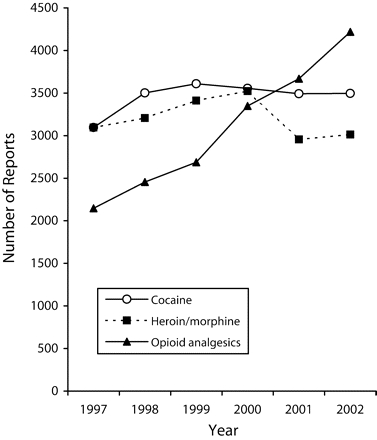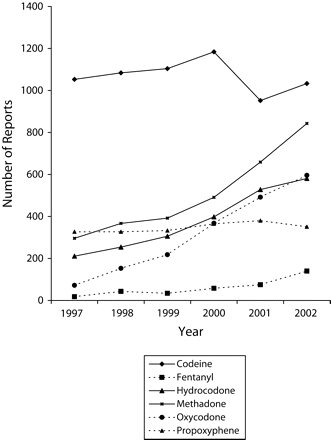Abstract
I measured the role of opioid analgesics in drug abuse–related deaths in a consistent panel of 28 metropolitan areas from the Drug Abuse Warning Network. The number of reports of opioid analgesics increased 96.6% from 1997 to 2002; methadone, oxycodone, and unspecified opioid analgesics accounted for 74.3% of the increase. Oxycodone reports increased 727.8% (from 72 to 596 reports). By 2002, opioid analgesics were noted more frequently than were heroin or cocaine. Dramatic increases in the availability of such opioids have made their abuse a major, growing problem.
Opioid analgesics are painkillers derived from opium or have an opiumlike effect. The drug class includes both short-acting forms of drugs such as propoxyphene and hydrocodone, which are most often formulated with nonopioid analgesics such as acetaminophen (e.g., Vicodin), and long-acting drugs such as OxyContin and methadone, which produce analgesia for up to 24 hours. The latter group of drugs has been the subject of recent publicity because of their adoption by drug abusers.1,2
Much of the publicity has focused on opioid analgesics in rural areas such as Appalachia or in rural states such as Maine.3 Higher fatal prescription drug overdose rates have been reported in the more rural areas within states.4–6 Rates increased by 317% in rural Utah between 1991 to 1998 and 1999 to 2003.4 The sharpest increase in admissions for substance abuse treatment involving narcotic painkillers has occurred in rural areas.7
I conducted this study to determine whether urban areas were experiencing similar increases in overdose fatalities and admissions for substance abuse treatment for analgesics and to ascertain how overdoses of these licit drugs compared to those of the illicit drugs heroin and cocaine. I also sought to determine the most common types of opioid analgesics involved.
METHODS
The Drug Abuse Warning Network (DAWN) medical examiner and coroner surveillance system provided information on fatalities associated with drug abuse. Fatalities associated with the legitimate use of a drug were not included in DAWN. From 1997 to 2002, deaths eligible for DAWN were those among people aged 6 to 97 years in which drug abuse either caused or contributed to the death. All such deaths are routinely investigated by medical examiners or coroners nationwide. Approximately 85% of deaths are ruled as unintentional or of undetermined intent by DAWN; about 15% are suicides. Homicides are excluded.
DAWN provided counts of reports of heroin, cocaine, and opioid analgesics of all types from among deaths reported by a panel of 28 urban medical examiner jurisdictions that filed reports for at least 10 months of each year from 1997 through 2002. The panel’s population was 67 million in 2002, an average of 2.4 million people per jurisdiction (range = 0.6–7.7 million).8
Medical examiners and coroners can report up to 6 drugs per death to DAWN. When multiple drugs are reported, as is typical, DAWN cannot attribute the death to any one drug, so the number of drugs reported exceeds the number of deaths. Heroin metabolites cannot be distinguished chemically from the opioid analgesic morphine, so DAWN combines the heroin and morphine categories.
RESULTS
The DAWN panel reported that the number of deaths from all drugs increased 27.2%—from 6948 in 1997 to 8837 in 2002. The rate per 100 000 increased 15.2%—from 11.4 in 1997 to 13.2 in 2002. The total number of reports of heroin, cocaine, and opioid analgesics among these deaths increased 28.7%—from 8336 in 1997 to 10 727 in 2002. The number of reports of opioid analgesics increased 96.6% over this span (Figure 1 ▶). Cocaine reports increased 12.9%; heroin or morphine reports declined 2.7%. By 2001, opioid analgesics displaced both heroin or morphine and cocaine as the most common type of drug reported.
FIGURE 1—

Reports of cocaine, heroin or morphine, and opioid analgesics from selected Drug Abuse Warning Network (DAWN) medical examiners, 1997–2002.
Note. The DAWN consistent panel included jurisdictions from the metropolitan areas of Atlanta, Ga; Baltimore, Md; Birmingham, Ala; Boston, Mass; Buffalo, NY; Chicago, Ill; Cleveland, Ohio; Dallas, Tex; Denver, Colo; Detroit, Mich; Kansas City, Mo; Las Vegas, Nev; Long Island, NY; Louisville, Ky; Miami, Fla; Minneapolis, Minn; New Orleans, La; Newark, NJ; Omaha, Neb; Philadelphia, Pa; Phoenix, Ariz; Portland, Ore; St. Louis, Mo; Salt Lake City, Utah; San Diego, Calif; San Francisco, Calif; Seattle, Wash; and Washington, DC.
Within the opioid analgesic category, large increases occurred for oxycodone (727.8%, from 72 to 596 reports), fentanyl (677.8%, from 18 to 140 reports), methadone (184.8%, from 296 to 843 reports), and hydrocodone (175.3%, from 97 to 568 reports; Figure 2 ▶). Reports of unspecified opioid analgesics (not shown) increased 485.6%. Codeine and propoxyphene showed little net change. Methadone accounted for 26.3% of the overall increase in this category; oxycodone accounted for 25.3%, unspecified opioid analgesics for 22.7%, hydrocodone for 17.8%, and fentanyl for 5.9%.
FIGURE 2—

Reports of opioid analgesics, by major type, from selected Drug Abuse Warning Network medical examiners, 1997–2002.
DISCUSSION
Multiple urban areas have experienced a dramatic increase in both drug abuse deaths and the involvement of opioid analgesics in those deaths between 1997 and 2002. Methadone and oxycodone account for the majority of the increase in opioid-involved deaths. By 2002, opioid analgesics were involved in more deaths than either of the illicit drugs responsible for most urban drug abuse in the 1990s: heroin and cocaine. These trends are generally consistent with trends in drug-related emergency department visits reported by DAWN from 1997 to 2002: a 101.4% increase in opioid analgesics, a 23.7% increase in cocaine, and a 32.2% increase in heroin.9
The increased involvement of these analgesics is related to exponential growth in their domestic sales over the past decade as physicians began to treat chronic pain with stronger analgesics.10 Oxycodone sales in grams increased 402.9% from 1997 to 2002; methadone (excluding that used in narcotics treatment programs) increased 410.8%; and fentanyl increased 226.7%.11 OxyContin, introduced in 1996, accounted for 68% of oxycodone sales by 2002.
The large contribution to mortality from oxycodone and methadone may be because of the long duration of action of methadone and OxyContin. Drug users may accidentally overdose by overlapping doses when the desired euphoric or analgesic effect is slow in coming. Abusers have learned to ingest and inject pulverized OxyContin pills, defeating the controlled-release mechanism and releasing dangerous amounts of the drug within a short time.12
My study was limited in that it could not determine whether medical examiners have begun to search more aggressively for opioid analgesics in overdose deaths because of recent publicity surrounding the issue or have improved their toxicological test procedures for opioids. However, such factors are not expected to have increased the rate of drug overdose deaths.
These metropolitan area data probably underestimate the current problem nationwide. First, because sales of opioids continued to increase through the first half of 2004,11 opioid involvement in such deaths has probably increased since 2002. Second, the diversion of some opioids to abusers may be a growing problem, given that the frequency of DAWN medical examiner reports of oxycodone and fentanyl are increasing even faster than are sales of those drugs. Third, as mentioned, problems with such drugs in rural areas of the United States may be even greater than are those in urban areas. Although these data cannot be extrapolated to the entire United States, they are strong enough and consistent enough with other lines of evidence to suggest that the problem demands urgent attention from agencies that regulate prescription painkillers prone to abuse within the United States.
Acknowledgments
The author thanks Elizabeth H. Crane, Office of Applied Studies, Substance Abuse and Mental Health Services Administration, for providing the Drug Abuse Warning Network data.
Note. The findings and conclusions in this brief are those of the author and do not necessarily represent the views of the Centers for Disease Control and Prevention.
Human Participant Protection. No protocol approval was needed for this study.
Peer Reviewed
References
- 1.Roche T. The potent perils of a new drug. Time Magazine. January 8, 2001:47. [PubMed]
- 2.White J. Virginia police fear rise of new drug. Washington Post. February 10, 2001:B2.
- 3.Sorg MH, Greenwald M. Maine drug-related mortality patterns: 1997–2002. Available at: http://www.state.me.us/ag/pr/drugreport.pdf. Accessed August 13, 2004.
- 4.Centers for Disease Control and Prevention. Increase in poisoning deaths caused by non-illicit drugs—Utah, 1991–2003. MMWR Morb Mortal Wkly Rep. 2005;54:33–36. [PubMed] [Google Scholar]
- 5.Shah N, Landen MG. Unintentional deaths from drug poisoning by urbanization of area—New Mexico, 1994–2003. MMWR Morb Mortal Wkly Rep. 2005; 54:870–873. [PubMed] [Google Scholar]
- 6.Sanford C. Deaths from unintentional drug overdoses in North Carolina, 1997–2001: a DHHS investigation into unintentional poisoning-related deaths. Available at: http://www.dhhs.state.nc.us. Accessed July 6, 2004.
- 7.Drug and Alcohol Services Information System, Office of Applied Studies. The DASIS Report—treatment admissions in urban and rural areas involving abuse of narcotic painkillers: 2002 update. Available at: www.oas.samhsa.gov/2k4/ruralPainTX/ruralPainTX.pdf. Accessed December 17, 2004.
- 8.US Dept of Health and Human Services (USD-HHS), Substance Abuse and Mental Health Services Administration, Office of Applied Studies, and Drug Abuse Warning Network. Mortality data from the Drug Abuse Warning Network, 2002. Available at: http://DAWNinfo.samhsa.gov/old_dawn/pubs_94_02/mepubs/default.asp. Accessed December 16, 2004.
- 9.US Dept of Health and Human Services (USDHHS), Substance Abuse and Mental Health Services Administration, Office of Applied Studies, and Drug Abuse Warning Network. The DAWN Report—trends in drug-related emergency department visits, 1994–2002 at a glance. Available at: http://dawninfo.samhsa.gov/old_dawn/pubs_94_02/shortreports/files/DAWN_EDvisits_glance.pdf. Accessed December 17, 2004.
- 10.Novak S, Nemeth WC, Lawson KA. Trends in medical use and abuse of sustained-release opioid analgesics: a revisit. Pain Med. 2004;5:59–65. [DOI] [PubMed] [Google Scholar]
- 11.Drug Enforcement Administration, US Dept of Justice. ARCOS: Automation of Reports and Consolidated Orders System. Available at: http://www.deadiversion.usdoj.gov/arcos/index.html. Accessed March 27, 2005.
- 12.Drug Enforcement Administration, US Dept of Justice. Drug intelligence brief—OxyContin: pharmaceutical diversion. Available at: http://www.usdoj.gov/dea/pubs/intel/02017/02017.html. Accessed December 17, 2004.


